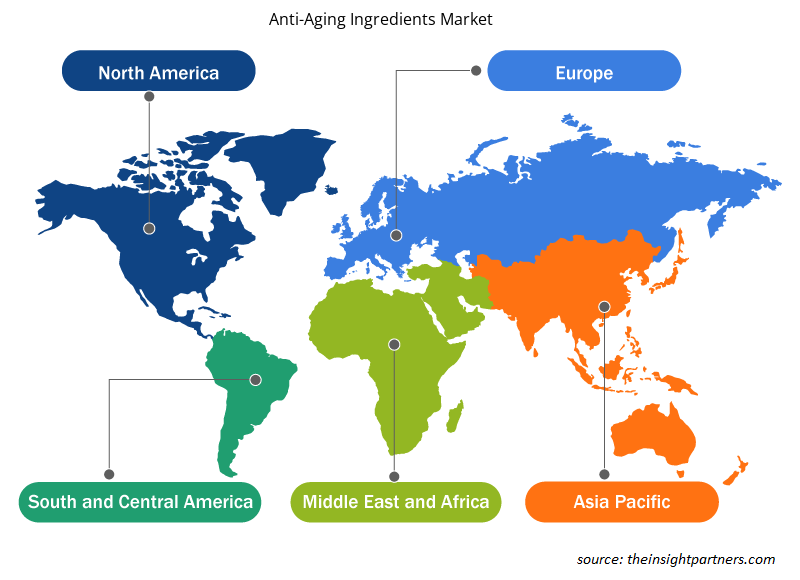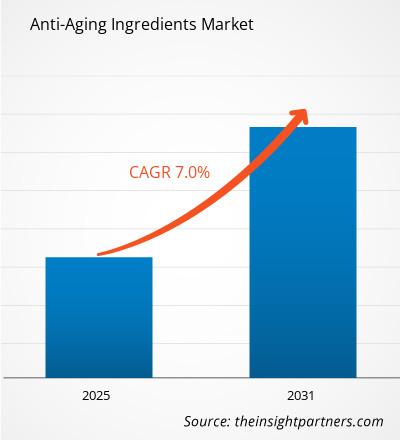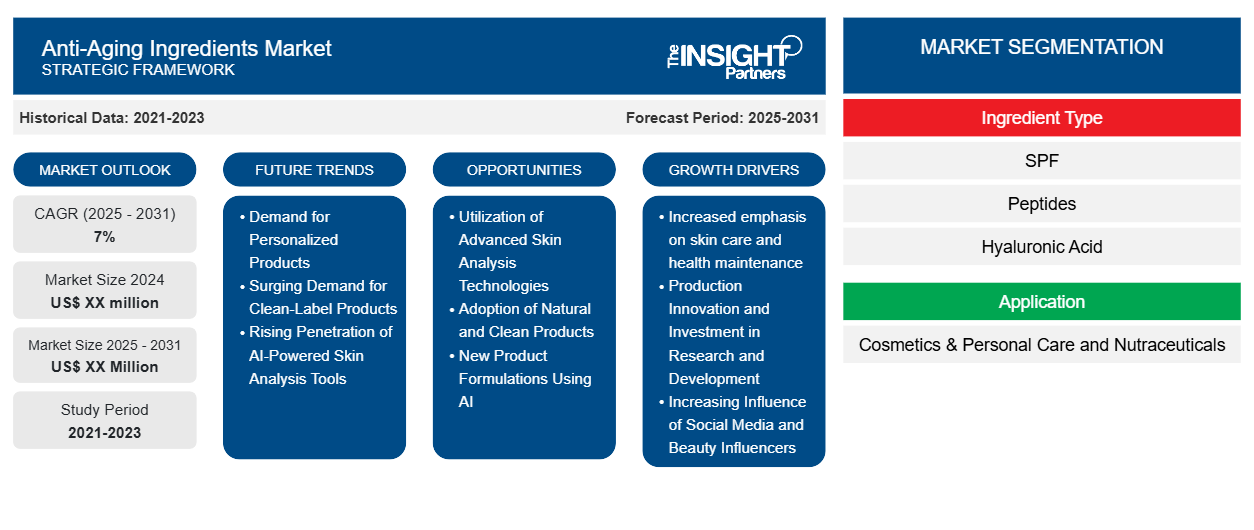预计抗衰老成分市场在 2024 年至 2031 年期间的复合年增长率为 7%,市场规模将从 2024 年的 XX 百万美元扩大到 2031 年的 XX 百万美元。
报告按成分类型(SPF、多肽、透明质酸、抗氧化剂、视黄醇、烟酰胺、神经酰胺等)进行细分。全球分析进一步细分为区域和主要国家。报告进一步根据应用(化妆品和个人护理以及保健食品)进行分析。全球分析进一步细分为区域和主要国家。范围涵盖所有主要细分市场的全球、区域和国家层面的市场规模和预测。报告以美元提供上述分析和细分市场的价值。报告提供主要市场参与者的市场状况关键统计数据,并提供市场趋势和机会。
报告目的
The Insight Partners 发布的《抗衰老成分市场》报告旨在描述当前形势和未来增长、主要驱动因素、挑战和机遇。这将为各种业务利益相关者提供见解,例如:
- 技术提供商/制造商:了解不断变化的市场动态并了解潜在的增长机会,从而能够做出明智的战略决策。
- 投资者:对市场增长率、市场财务预测以及整个价值链中存在的机会进行全面的趋势分析。
- 监管机构:监管市场政策和警察活动,旨在最大限度地减少滥用行为,维护投资者的信任和信心,维护市场的完整性和稳定性。
抗衰老成分市场细分
成分类型
- 防晒指数
- 肽
- 透明质酸 Acid
- 抗氧化剂
- 视黄醇
- 烟酰胺
- 神经酰胺
- 其他的
应用
- 化妆品、个人护理和保健食品Nutraceuticals
定制此报告以满足您的需求
您可以免费定制任何报告,包括本报告的部分内容、国家级分析、Excel 数据包,以及为初创企业和大学提供优惠和折扣
- 获取此报告的关键市场趋势。这个免费样品将包括数据分析,从市场趋势到估计和预测。
抗衰老成分市场增长动力
- 更加重视皮肤护理和健康维护:消费者更加重视皮肤护理和健康维护,这增加了抗衰老产品的使用。随着对生理学和皮肤衰老过程的了解不断加深,预防性皮肤护理措施的需求日益增加,尤其是希望延缓衰老过程的年轻人。
- 生产创新和研发投资:各种化学品应用的研发创新已导致激光技术抗衰老乳液的出现。新技术将活性成分(如类视黄醇和肽)与抗氧化剂相结合,以提高其功效。这种创新鼓励了那些寻求以结果为导向的产品的消费者,从而推动了市场的增长。
- 社交媒体和美容影响者的影响力不断增强:社交网络和美容影响者对客户偏好的影响很大。由于这些产品的需求量很大,消费者对它们更加友好,并希望获得有效的抗衰老解决方案,包括美容护肤产品中的优质抗衰老活性成分。
抗衰老成分市场未来趋势
- 个性化产品需求:这是一个个性化的时代,可以想象,这方面也会影响抗衰老成分市场。随着生物技术和皮肤病学研究的发展,不仅可以制造通用产品,还可以制造适合不同个体不同皮肤类型的特殊抗衰老霜。
- 清洁标签产品需求激增:随着人们越来越关注自己的健康,人们越来越关注使用清洁标签抗衰老产品。Jahar 还强调,这将使更多公司致力于使用有机和植物成分,因为它满足了人们对安全无毒护肤解决方案的需求,这将成为市场未来发展方向的因素。
- 人工智能皮肤分析工具的普及率不断提高:预计在这个不断增长的市场中,使用人工智能配制产品和皮肤分析设备等技术将极大地促进抗衰老市场的产品开发过程。这些技术可能对希望开发精致和先进的抗衰老产品的品牌具有成本效益,这些产品将吸引热衷于技术的现代消费者。
抗衰老成分的市场机会
- 利用先进的皮肤分析技术:消费者对个性化护肤产品的偏好日益增加,这为抗衰老成分市场带来了巨大机遇。公司可以利用皮肤分析和基因检测等先进技术来开发满足个人需求的定制配方,从而提高客户满意度和忠诚度。
- 采用天然和清洁产品:随着消费者越来越注重健康,人们越来越倾向于使用清洁和天然的美容产品。这一趋势为抗衰老成分供应商提供了一个机会,让他们专注于有机、可持续来源和无毒配方,以吸引环保意识强的消费者,从而开拓新的细分市场。
- 使用人工智能开发新产品配方:将人工智能和机器学习等技术融入产品配方和消费者互动中,为抗衰老成分市场创造了创新机会。品牌可以开发有效的数据驱动配方,同时利用技术进行有针对性的营销,从而增强竞争优势。
抗衰老成分市场区域洞察
Insight Partners 的分析师已详尽解释了预测期内影响抗衰老成分市场的区域趋势和因素。本节还讨论了北美、欧洲、亚太地区、中东和非洲以及南美和中美洲的抗衰老成分市场细分和地理位置。

- 获取抗衰老成分市场的区域特定数据
抗衰老成分市场报告范围
| 报告属性 | 细节 |
|---|---|
| 2024 年的市场规模 | XX 百万美元 |
| 2031 年市场规模 | XX 百万美元 |
| 全球复合年增长率(2025 - 2031) | 7% |
| 史料 | 2021-2023 |
| 预测期 | 2025-2031 |
| 涵盖的领域 | 按成分类型
|
| 覆盖地区和国家 | 北美
|
| 市场领导者和主要公司简介 |
|
抗衰老成分市场参与者密度:了解其对业务动态的影响
抗衰老成分市场正在快速增长,这得益于终端用户需求的不断增长,而这些需求又源于消费者偏好的不断变化、技术进步以及对产品优势的认识不断提高等因素。随着需求的增加,企业正在扩大其产品范围,进行创新以满足消费者的需求,并利用新兴趋势,从而进一步推动市场增长。
市场参与者密度是指在特定市场或行业内运营的企业或公司的分布情况。它表明在给定市场空间中,相对于其规模或总市场价值,有多少竞争对手(市场参与者)存在。
在抗衰老成分市场运营的主要公司有:
- 阿德卡公司
- 康蒂普罗公司
- 拜尔斯道夫公司
- 生物繁荣科学公司
- 花王株式会社
- 资生堂
免责声明:上面列出的公司没有按照任何特定顺序排列。

- 了解抗衰老成分市场顶级关键参与者概况
主要卖点
- 全面覆盖:报告全面涵盖了抗衰老成分市场的产品、服务、类型和最终用户的分析,提供了整体概况。
- 专家分析:报告基于对行业专家和分析师的深入了解而编写。
- 最新信息:该报告涵盖了最新信息和数据趋势,确保了其与业务的相关性。
- 定制选项:此报告可以定制以满足特定客户要求并恰当地适应业务策略。
因此,抗衰老成分市场研究报告有助于引领解读和了解行业情景和增长前景。尽管可能存在一些合理的担忧,但本报告的总体优势往往大于劣势。
- 历史分析(2 年)、基准年、预测(7 年)及复合年增长率
- PEST和SWOT分析
- 市场规模、价值/数量 - 全球、区域、国家
- 行业和竞争格局
- Excel 数据集
近期报告
客户评价
购买理由
- 明智的决策
- 了解市场动态
- 竞争分析
- 客户洞察
- 市场预测
- 风险规避
- 战略规划
- 投资论证
- 识别新兴市场
- 优化营销策略
- 提升运营效率
- 顺应监管趋势





















 获取免费样品 - 抗衰老成分市场
获取免费样品 - 抗衰老成分市场